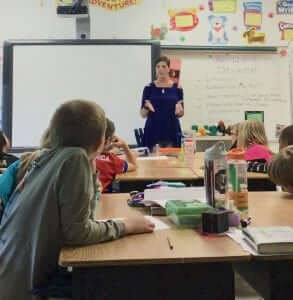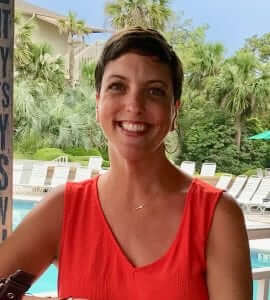This time of year is both sweet and poignant for teachers. As we finish our lessons and close up our classrooms, sometimes we get notes from our students expressing their appreciation for what they’ve learned. Our hearts melt. Sometimes kids who didn’t seem to be soaking up our teaching during the school year have unexpected, heartfelt, meaningful reflections to share. We hope you’re also savoring these memories as you transition to this well-deserved rest from teaching. Here are a few thank you notes that students wrote to our Mindful Teacher in South Carolina, Kara Foster-Lee.
Name: Kara Foster-Lee
Cohort: Mindful Teacher Class of 2018
School: Pelham Road Elementary
Location: Greenville, SC
Connect with me: on Facebook
About your school community: My school is a high-performing public school in Greenville County–the largest district in South Carolina. Students are motivated, and families are very involved. It’s a supportive environment, but students definitely feel the pressure to perform, and each year I see more and more anxiety in younger and younger children.
Tell us about your teaching.
I teach first grade and try to embed mindfulness in my classroom environment. I also visit a 4th grade class once a week during my planning period to teach them mindfulness.
Taking the Mindful Teacher certification program inspired me to provide some additional support to our faculty. It’s a wonderful school, but we’re all facing some very high standards. Many of us are stressed from attempting to balance work and life. So I began to offer Time-Out Tuesdays for 15 minutes after school, where we do a simple mindfulness practice, such as focus on an anchor point for breathing or noticing the relationship between emotions and sensations. Then I lead them through a 5-minute guided sit. My colleagues discover how just a quick check-in with our breath can re-calibrate our day.
Your students mention a 4-3-2-1 practice. What’s that for?
I explain to students that stress can cause us to have “tunnel vision” — we lose our peripheral vision and become unable to focus on anything other than what is causing the stress. When we re-engage our senses, we re-orient ourselves. We are able to take that necessary step away from the stressor and get some space in between the intense reaction and the more measured response. The activity is both quick and effective. For example, when students take tests, they often get anxious. So when they notice this feeling they can re-engage their senses with 4, 3, 2, 1.
 Teach us how to do it.
Teach us how to do it.
While taking slow, deep breaths, do the following:
4 – find 4 blue objects in the room.
3 – find 3 round things in the room.
2 – listen for 2 sounds inside the room.
1 – place your hands on your heart or pulse to check in with the body.
Many students mentioned this activity specifically as being very helpful when they took the state standardized tests. You can read more about the 4-3-2-1 practice here.
How else have you been sharing mindfulness in South Carolina?
This year I presented on “Mindfulness in the Classroom” to our district’s arts educators (over 300 in attendance), which led to an invitation to present to our district’s curriculum coordinators. That led to a presentation to administrators and arts educators from across the state at the Palmetto State Arts Educators Joint Arts Administrators Institute; then two principals invited me to present to their schools. This is exciting because they are not in my district, so I’ve been able to plant seeds across my state. I’m looking forward to presenting at the South Carolina Art Education Association annual meeting in December, working with trauma informed specialists from my district in October, and teaching education majors across the state through the CERRA program.
How did you come to the practice?
Two summers ago I attended a Mindfulness for Educators retreat. Jelena Popvic, a Mindful Teacher graduate, was one of the facilitators.
I had had an on-off meditation practice before, but attending that retreat lit a fire inside of me. Becoming aware of how my presence affects students, and the integration of neuroscience and mindfulness has profoundly changed the way I teach and move through my life.
How did you first start teaching mindfulness in your first grade class?
After I completed the Mindfulness Fundamentals and Mindful Educators Essentials I tried to really think about my language and presence, and how learning was unfolding in my classroom, as well as how we interact with one another. Dan Siegel’s The Whole Brain Child was instrumental in helping me tie together what I was learning from the classes, about myself and how I interacted with children.
To start, we just did a lot of breathing exercises. We used the Hoberman sphere, traced our hands while breathing in and out, and tried guided lessons from GoNoodle. Students were so responsive to these, and many shared the activities with their parents. I even incorporated mindfulness activities parents can share with their children into my weekly newsletter.
What were some struggles that you faced?
About three years ago, I found myself struggling as a teacher. I love the children, and seeing their growth over a year is an amazing privilege. However, I was very conflicted about the amount of pressure we place on students; I am still conflicted about the overemphasis on “brain smarts,” much to the detriment of what I call “heart smarts.” I visited some alternative schools, mostly private, but ended up staying put. Public education can be a powerful tool in helping our society become more inclusive, accepting and tolerant. Mindfulness has provided me with the tools not only to embody these characteristics, but also to teach them in accessible and age appropriate ways. My practice helps me sit with these feelings of conflict and concern in more self-compassionate ways. I still struggle, often, but my whole approach to my role has changed.
 Now that it’s summer, what will you do for fun?
Now that it’s summer, what will you do for fun?
I am looking forward to some time off to sleep in, read, and relax with my dog. The thing I’m most excited about, however, is the Mindful Teacher retreat at the Garrison Institute in July.
Thanks Kara for sharing your story!
If you’re interested in sharing your own story with our community here, or if you want to learn more about joining our community, simply reach out to us at community@mindfulschools.org. We love hearing more about your experiences and what you’re learning.


 Teach us how to do it.
Teach us how to do it. Now that it’s summer, what will you do for fun?
Now that it’s summer, what will you do for fun?